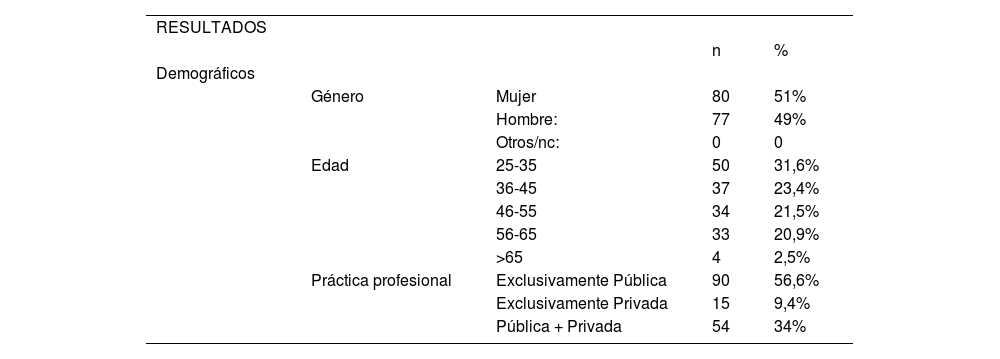Conocer el estado actual del manejo de las oclusiones arteriales retinianas (OAR) en España.
Material y métodosSe realizó un cuestionario anónimo de 22 preguntas en la plataforma Google Forms®, entre el 27 de abril y el 28 de mayo de 2023. Este cuestionario se difundió vía email por la Sociedad Española de Retina y Vítreo y la Sociedad Española de Oftalmología.
ResultadosContestaron 159 oftalmólogos de 91 centros públicos y 44 centros privados, de las 17 comunidades autónomas. El 51% de los oftalmólogos que respondieron la encuesta fueron mujeres. El 56,6% ejerce su trabajo en centros públicos, el 9,4% en centros privados y el 34% combinan ambos centros.
De los oftalmólogos que trabajan en centros públicos, el 41,7% atienden urgencias oftalmológicas de manera presencial las 24 horas del día los 365 días de año, mientras el resto demoran su atención fuera del horario habitual. En el 62,6% de los centros públicos con respuestas recogidas no hay protocolos para el manejo de la OAR en los servicios de oftalmología y en cuanto a protocolos multidisciplinares, el 57% reconoce que no tiene, el 23% tiene con neurología o medicina interna y solo un 13% de los centros incluyen las OAR dentro del código ictus. Los tratamientos que se reportan con mayor frecuencia son los hipotensores y la paracentesis de cámara anterior.
En los centros privados el 73,7% refieren no tener un protocolo propio, ni tampoco con otros servicios en un 78,9%.
En cuanto las principales barreras percibidas por los oftalmólogos encuestados destacan: los pacientes llegan fuera del periodo ventana (77,2%), no existe tratamiento específico y la falta de protocolos establecidos (55,4%), baja incidencia (32,9%).
Las sugerencias de mejora fueron: necesidad de implantar protocolos, coordinación con otros servicios y que se incluya la OAR como código ictus.
ConclusionesPese a sus limitaciones (cuestionario simple, diseño abierto de algunas preguntas, falta de representación de centros y provincias y respuestas contradictorias dentro de un mismo centro), consideramos que puede servir como aproximación al manejo actual de las OAR en España. Es necesario desarrollar protocolos adaptados a los diferentes centros y cumplirlos de forma efectiva para mejorar accesibilidad y equidad.
To determine the current status of the management of retinal artery occlusion (RAO) in Spain.
Material and methodsWe conducted an anonymous 22-question survey questionnaire on Google Forms® from April 27th through May 28th, 2023. This survey was distributed by e-mail by the Spanish Vitreo-Retinal Society and the Spanish Society of Ophthalmology.
ResultsA total of 159 ophthalmologists from 91 public and 44 private centers across the 17 autonomous communities answered the survey. A total of 5% of respondents were women, 56.6% worked in public centers, 9.4% in private centers and 34% in both centers.
A total of 41.7% of the ophthalmologists working in public centers were also in charge of eye emergencies on a 24-h basis, 365 days/year, while the rest delay the management of these emergencies outside their working hours. In 62.6% of the public centers with responses collected there are no protocols for the management of RAO in the ophthalmology services and as for multidisciplinary protocols, 57% recognize that they do not have one, 23% have one along with neurology or internal medicine and only 13% of the centers include RAO as parte of their stroke code. The most widely reported therapies are hypotensive drugs and anterior chamber paracentesis.
A total of 73.7% of private centers reported not having their own protocol, and 78.9% not having any protocol with any other services. The main barriers perceived by the respondents were patients arriving outside the window period (77.2%), no specific treatment and lack of established protocols (55.4%), and a low incidence rate (32.9%).
Suggestions for improvement were the need for implementing the protocols, coordination with other services and that RAO should be included as part of their stroke code.
ConclusionsDespite its limitations (simple questionnaire, open design of some questions, no center and provincial representation, and contradictory responses within the same center), the survey can serve as an approximation to the current management of RAO in Spain. Protocols adapted to the different centers need to be developed and, then, followed effectively to improve accessibility and equity.
Artículo
Comprando el artículo el PDF del mismo podrá ser descargado
Precio 19,34 €
Comprar ahora










